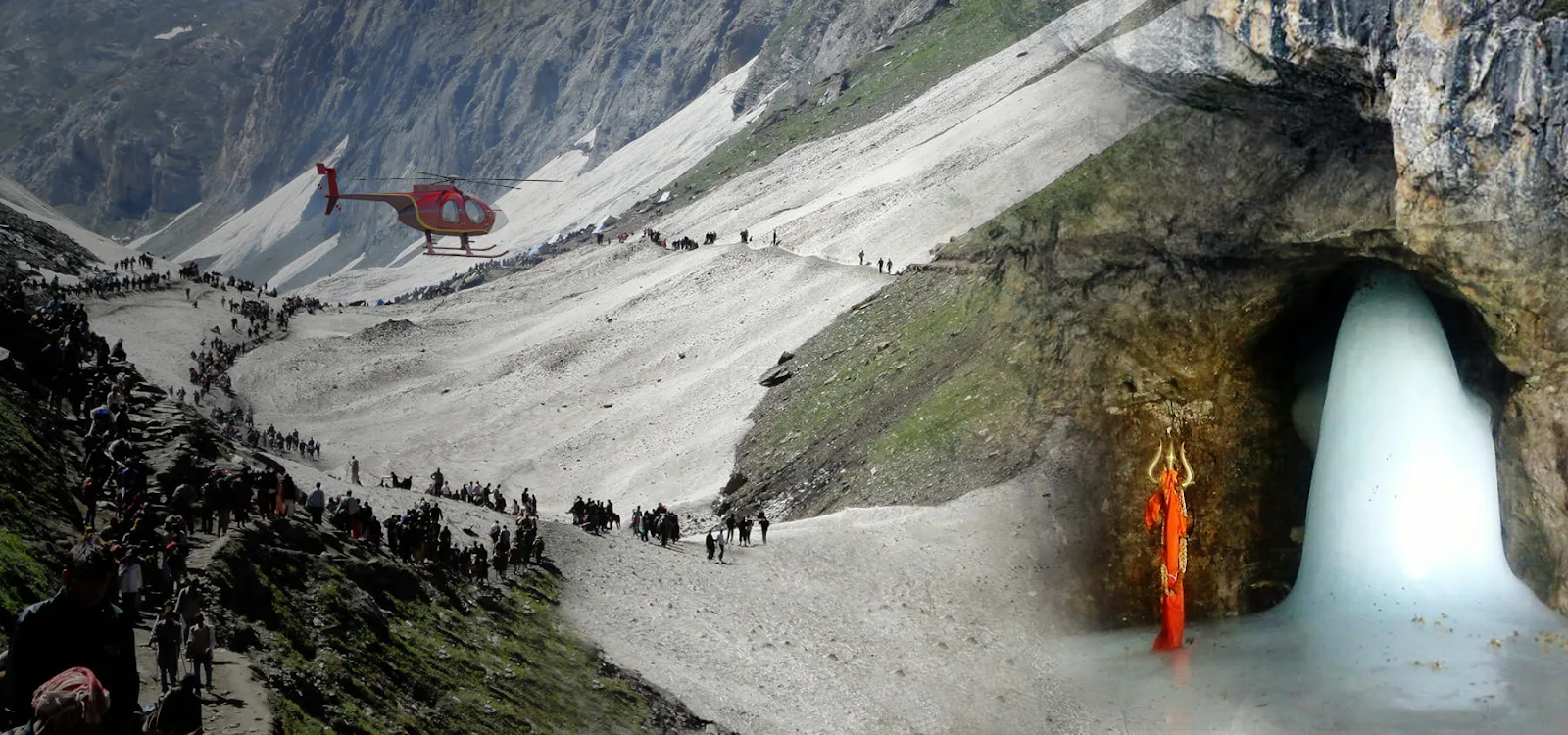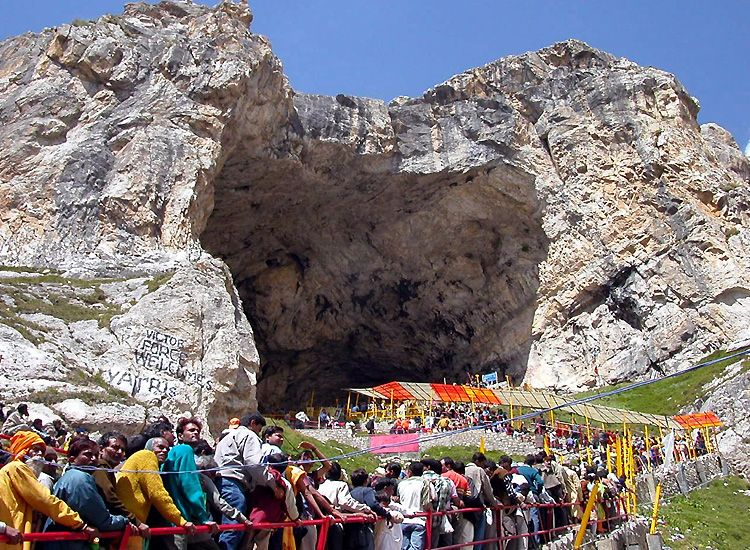Amarnath Yatra 2024: Dates, Registration, Routes, Helicopter, and Details
 Srijan Garg
29 Jun, 2024
18 mins read
13870
Srijan Garg
29 Jun, 2024
18 mins read
13870

The Amarnath Yatra is one of the most revered and challenging pilgrimages in Hinduism. Every year, thousands of devotees undertake this journey to the holy Amarnath Cave to seek the blessings of Lord Shiva. The yatra, which takes place during the Shravan month (July-August), is marked by the formation of a natural ice lingam, believed to represent Lord Shiva. In this blog, we'll provide all the essential information you need to plan your Amarnath Yatra 2024, including dates, registration process, routes, helicopter services, and important tips.
About Amarnath Yatra

The Amarnath Yatra is an annual pilgrimage that attracts lakhs of devotees who visit the holy Amarnath Cave during the Shravan month (July-August) of the Hindu calendar. Located at an altitude of 3,888 meters, about 141 kilometers from Srinagar in Jammu and Kashmir, the Amarnath Cave is accessible only during this period. This cave is home to a naturally formed ice Shiva Lingam, which is believed to grow and shrink with the phases of the moon, reaching its peak size during the summer festival.
The journey to the cave is both challenging and exhilarating, requiring not just physical endurance but also deep faith. The annual yatra begins with the 'Pratham Pujan,' invoking the blessings of Baba Amarnath, Lord Shiva.
Important Dates for Amarnath Yatra 2024
The Amarnath Yatra 2024 will commence on July 29th and will end on August 19th. The registration for the yatra begins on April 17th, 2024. It is crucial to register early as there is a limit of 10,000 yatris per day, excluding those traveling by helicopter.
Key Dates:
- Yatra Start Date: July 29, 2024
- Yatra End Date: August 19, 2024
- Registration Start Date: April 17, 2024
Registration Process for Amarnath Yatra 2024
The registration for Amarnath Yatra 2024 is done on a first-come, first-serve basis. Each yatri must submit an application form, a compulsory health certificate (CHC), and other required documents to obtain a yatra permit. The registration fee is INR 100 per yatri.
Steps to Register:
1. Application Form and Compulsory Health Certificate (CHC): Every yatri must submit a filled application form and a CHC issued by an authorized doctor or hospital.
2. Document Submission: The required documents include the CHC and a photo ID. These documents can be submitted at designated bank branches or online.
3. Online Registration: Visit the official website JKSASB to fill out the registration form and upload the necessary documents. The CHC must be in PDF format and the photo in JPEG/JPG format, not exceeding 1MB.
4. Group Registration: Since 2014, the Shri Amarnathji Shrine Board (SASB) has facilitated group registrations for yatris traveling together.
Amarnath Yatra Route
There are two primary routes to reach the Amarnath Cave:
Northern Route via Baltal

- Distance: 14 km
- Duration: 1-2 days (round trip)
- Details: This route is approximately 14 km long and is known for its steep ascent. It starts from Baltal and is ideal for those who prefer a shorter but more challenging trek. Due to safety reasons, ponies are not allowed on this route. Pilgrims can either walk or use Dandies (carried on a seat atop the shoulders of porters).
Traditional Route via Pahalgam

- Distance: 36-48 km
- Duration: 3-5 days (one way)
- Details: This is the traditional and longer route, favored by most pilgrims. The trek varies from 36 to 48 km and usually takes 3-5 days one way. The Pahalgam route is less steep compared to the Baltal route, making it more suitable for aged or ailing devotees. This route is also known for its scenic beauty and gradual ascent.
Amarnath Trek Distance

The length of the trek varies from 36 to 48 km depending on the devotion of the pilgrim. The trek usually takes 3-5 days one way. The Amarnath route is much wider than the Baltal trek and slopes gradually. However, one will also find it crowded by ponies for almost the whole of the route. Aged, sick, or people with a past history of illnesses are advised to take this yatra route.
Both routes are equipped with facilities provided by the Indian Army, Central Government, State Government, and various non-profit organizations. These include medical aid centers, resting camps, and food stalls.
Helicopter Services for Amarnath Yatra

For pilgrims seeking a quicker and more convenient option, helicopter services are available from Baltal and Pahalgam to Panjtarni, just 6 km away from the Amarnath Cave. This service is particularly beneficial for elderly pilgrims or those with physical limitations who find the trek challenging.
Key Details:
1. Helipad Locations: Helicopters operate from Baltal and Pahalgam.
2. Booking Process: It's essential to book helicopter tickets well in advance, especially during peak yatra season. Bookings can be made online, and each debit/credit card is allowed a maximum of five bookings.
3. Health Certificate Requirement: All passengers must possess a Compulsory Health Certificate (CHC) issued by authorized doctors or institutions specified by the Shri Amarnathji Shrine Board (SASB).
4. Journey to the Cave: Upon reaching Panjtarni, pilgrims embark on a 6 km trek to the Amarnath Cave. This trek, although shorter, requires careful consideration of altitude and weather conditions.
Essential Tips and Preparation for Amarnath Yatra 2024
Preparing for the Amarnath Yatra involves physical conditioning, acclimatization, and logistical readiness to ensure a safe and fulfilling pilgrimage experience.
Fitness Preparation:
- Begin a regimen of daily walking or hiking several weeks before the yatra to build stamina and endurance.
- Incorporate breathing exercises and yoga to improve lung capacity and oxygen efficiency, crucial for higher altitudes.
- Hydrate adequately before and during the yatra to prevent dehydration and altitude-related illnesses.
Altitude and Weather Considerations:
- Recognize the symptoms of altitude sickness, such as headache, nausea, and dizziness. Descend immediately if symptoms worsen.
- Pack appropriate clothing layers, including warm clothing for cold nights and rain gear for unpredictable weather conditions.
Safety Precautions:
- Carry a comprehensive first aid kit with essential medications, including those for altitude sickness, pain relief, and gastrointestinal issues.
- Stay informed about the latest weather forecasts and route conditions. Follow instructions from yatra authorities and guides regarding safety protocols.
Accommodation and Food Facilities Along the Amarnath Yatra Route
During the Amarnath Yatra, various accommodation options cater to the diverse needs of pilgrims, offering both comfort and convenience.
Accommodation Options:
1. Prefabricated Huts: Available at strategic locations such as Baltal, Nunwan, Sheshnag, and Panjtarni. These huts provide basic shelter with options for bedding and sanitary facilities.
2. Private Tents and Huts: Offered by private contractors along the route, these accommodations range from economical options to more luxurious setups, accommodating different budgets and preferences.
Food Facilities:
1. Langar Services: Non-profit organizations and volunteers set up Langars (community kitchens) at various points along the yatra route. They offer free meals and refreshments to pilgrims, promoting community spirit and support.
2. Restaurants and Tea Stalls: Small eateries and tea stalls provide additional food options, including local delicacies and beverages, catering to pilgrims' dietary preferences and cultural tastes.
Safety Measures and Support Services
The safety and well-being of pilgrims undertaking the Amarnath Yatra are paramount, supported by comprehensive safety measures and dedicated support services.
Medical and Emergency Support:
1. Medical Aid Centers (MACs): Strategically located MACs provide immediate medical assistance, including basic healthcare services and emergency treatment.
2. Emergency Aid Centers (EACs): Equipped with advanced medical facilities, EACs cater to critical medical emergencies and evacuations, ensuring prompt response and intervention.
Transportation and Communication:
1. Transport Facilities: The Jammu and Kashmir State Road Transport Corporation (JKSRTC) operates buses from Jammu to Pahalgam and Baltal, facilitating seamless travel logistics for pilgrims.
2. BSNL Connectivity: BSNL connectivity is available along the yatra route, with pre-loaded yatra SIMs available for INR 230, supporting pilgrims with communication needs. Pre-loaded yatra SIM cards are available for purchase, ensuring connectivity in remote areas.
The Legend of Amarnath

The Amarnath Yatra legend tells of Lord Shiva revealing the secrets of life and eternity to Goddess Parvati inside the Amarnath Cave. This sacred journey symbolizes letting go of worldly attachments, much like Shiva did by leaving his companions behind on the way to the cave. Each year, millions of pilgrims embark on this challenging trek in the Himalayas, seeking spiritual enlightenment and divine blessings where Shiva meditated. The Amarnath Yatra is not just a pilgrimage but a profound spiritual experience that attracts devotees from around the world.
Nearby Attractions
While on the Amarnath Yatra, take the opportunity to visit the beautiful nearby locations such as Srinagar, Gulmarg, and Sonamarg. These places offer breathtaking landscapes and a serene environment, enhancing the overall pilgrimage experience.
Final Tips for a Safe and Enjoyable Yatra
1. Fitness: Prepare for the yatra by walking 4-5 km daily and practicing breathing exercises.
2. Hydration: Drink plenty of water to stay hydrated.
3. Altitude Sickness: If you experience symptoms of altitude sickness, descend immediately and seek medical help at the nearest facility.
4. Avoid Alcohol and Caffeine: These can exacerbate dehydration and altitude sickness.
5. Medical Check: Carry your original Photo ID and Medical Certificate at all times.
Final Thoughts
The Amarnath Yatra is not just a pilgrimage but a journey of faith, devotion, and resilience. By following the guidelines and preparing adequately, yatris can ensure a safe and fulfilling yatra in 2024. May the blessings of Lord Shiva guide and protect all devotees on this sacred journey.
Prepare well, stay safe, and embark on this spiritual quest with a heart full of devotion. Safe travels & Om Namah Shivaya!
For more information and updates, visit the official Shri Amarnathji Shrine Board.
Written By:
Srijan Garg



Hotels at your convenience
Now choose your stay according to your preference. From finding a place for your dream destination or a mere weekend getaway to business accommodations or brief stay, we have got you covered. Explore hotels as per your mood.





